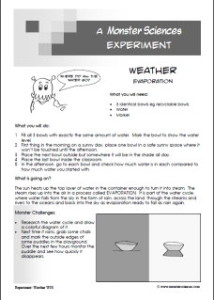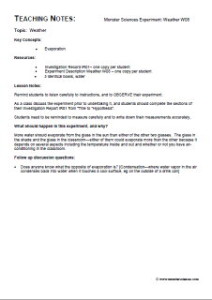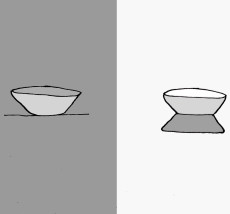Observe how water naturally evaporates and study what factors might affect the rates of evaporation.
 |
 |
What you will need:
- 3 identical bowls eg recyclable bowls
- Water
- Marker
What you will do:
1 Fill all 3 bowls with exactly the same amount of water. Mark the bowl to show the water level.
2 First thing in the morning on a sunny day, place one bowl in a safe sunny space where it won’t be touched until the afternoon.
3 Place the next bowl outside but somewhere it will be in the shade all day.
4 Place the last bowl inside the classroom.
5 In the afternoon, go to each bowl and check how much water is in each compared to how much water you started with.
What is going on?
The sun heats up the top layer of water in the container enough to turn it into steam. The steam rises up into the air in a process called EVAPORATION. It is part of the water cycle, where water falls from the sky in the form of rain, across the land, through the streams and rivers to the oceans and back into the sky as evaporation ready to fall as rain again.
Monster Challenges:
- Research the water cycle and draw a colorful diagram of it.
- Next time it rains, grab some chalk and mark the outside edges of some puddles in the playground. Over the next few hours monitor the puddle and see how quickly it disappears.
Teaching Notes:
Topic: Weather
Key Concepts:
¨ Evaporation
Resources:
- Investigation Record IR01– one copy per student
- Experiment Description Weather W08 – one copy per student
- 3 identical bowls, water
Lesson Notes:
Remind students to listen carefully to instructions, and to OBSERVE their experiment.
As a class discuss the experiment prior to undertaking it, and students should complete the sections of their Investigation Report IR01 from ”Title to “Hypothesis”.
Students need to be reminded to measure carefully and to write down their measurements accurately.
What should happen in this experiment, and why?
More water should evaporate from the glass in the sun than either of the other two glasses. The glass in the shade and the glass in the classroom—either of them could evaporate more than the other because it depends on several aspects including the temperature inside and out and whether or not you have air-conditioning in the classroom.
Follow up discussion questions:
- Does anyone know what the opposite of evaporation is? [Condensation—where water vapor in the air condenses back into water when it touches a cool surface, eg on the outside of a drink can]
Get this experiment here or as part of a bundle of Weather Experiments here.



